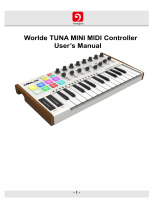
Quick Start
Introduction
SetupProgram
Combination
Sequencer
SamplingGlobalMediaEffectKARMA
Drum Track
Other
Appendices
7
Introduction to the M3
Main Features
Rich and vivid sound produced by new EDS
(Enhanced Definition Synthesis) sound gen-
erator
The new “EDS” (Enhanced Definition Synthesis)
sound generation system is based on PCM sources
refined using Korg’s proprietary voicing technology,
and delivers rich and vivid sounds.
Each voice has oscillators (two oscillators allowing
four-stage velocity switching/crossfading/layering)
that can use up to eight (stereo) multisamples, up to
four filters (two filters each with four modes and four
routings), two amps, five LFOs, and five EGs, all
available simultaneously.
The oscillator section provides a total of 1,032
multisamples (including seven stereo multisamples)
sampled at 48 kHz, as well as 1,606 drum samples
(including 116 stereo drum samples), giving you a total
of 256 Mbytes of sample data (when considered as 16-
bit linear data). These PCM sources are available for
use in the oscillator section via four-way velocity
switching/crossfading/layering to create a broad
range of expressive, high-quality sounds.
The filter section that’s so vital to creative sound-
making lets you simultaneously use two filters for each
oscillator. Filter types include low-pass, high-pass,
band-pass, and band-reject (notch). You can use the
two filters in any of four routings: single, serial,
parallel, or 24 dB mode.
The amp section provides a driver circuit that adds
edge and character to the sound.
The key tracking generator allows the filtering to vary
according to the keyboard range; you can apply subtle
filtering for convincing simulation sounds, or
aggressive filtering that produces drastic changes in
filtering as you play up or down the keyboard.
The M3 takes advantage of its lavish amount of
available processing power to produce ultra-fast and
ultra-smooth EGs (envelope generators) and LFOs.
EGs allow you to specify how the sound develops over
time, from its onset to its end. The each EG stage
(attack, decay, slope, and release), giving you detailed
control over how the tone and volume change over
time, and making it possible to program anything from
simulated acoustic sounds to vintage synthesizer
sounds in the utmost detail.
Korg’s AMS (Alternate Modulation Sources) give you a
rich array of modulation possibilities, with 50 different
modulation sources you can use to control the sound in
complex ways. The M3 takes this classic Korg feature
even further, via the AMS Mixers. These let you create
even more detailed modulation designs, such as
mixing two modulation sources together, multiplying
one modulation source by another, or modifying the
shape of the modulation source in various ways.
Programs, Drum Tracks, and each of the sixteen
timbres/tracks has its three-band EQ, letting you make
detailed adjustments to the tonal character.
To let you shape the final character of the overall
sound, the effect section provides up to five insert
effects, two master effects, and one total effect. In
addition to delay and reverb, the total of 170 high-
quality effects includes modulation-type effects such as
chorus, phaser, and flanger, dynamic-type effects such
as compressor and limiter, and amp-modeling effects
generated using Korg’s proprietary “REMS” modeling
technology. There are also two common LFOs that can
be shared between different modulation effects. For
example, you can create sophisticated effects such as
using a single common LFO to synchronize the
modulation frequency of a phaser and a flanger used
on different timbres. Effect dynamic modulation
(Dmod) lets you control the sound or effects in a wide
variety of ways, ranging from the subtle to the
dramatic.
Use the KARMA function, Drum Track func-
tion, Open Sampling System, and 16-track
MIDI sequencer to bring your ideas into com-
pletion in this seamless new production envi-
ronment
The M3 provides many new functions that help you
turn your ideas into songs quickly and intuitively.
The Drum Track function lets you listen to drum
patterns while you construct the outline of your song.
You can easily select the M3’s built-in patterns or
patterns that you’ve created, and start the pattern from
a specified region of the keyboard or by playing a
velocity higher than a specified threshold.
This function is also useful for anything from realtime
performance to generating sketches for song
production
The M3 also provides the amazing KARMA function,
giving you an enormous amount of musically
expressive potential. This provides a powerful boost to
your music production power, letting you can use up
to four KARMA modules to create complex layered
textures or produce natural performance gestures that
are idiomatic to a wide range of instruments.
Sampling functionality is provided by the Open
Sampling System which lets you sample or resample
while in any mode (Program or Combination, etc.).
You can also perform a rich array of sample editing
commands including Time Stretch and Time Slice. In
Sequencer mode you can perform in-track sampling,
letting you sample while your song plays back, just as
if you were recording an audio track. In addition to
Korg format sample data, you can also load sample
data in a wide range of formats including WAVE, AIFF,
Akai S1000/S3000, and SoundFont 2.0 formats for
music production or performance.
Auto Song Setup is a function that makes it easy to
record programs, drum tracks, or combinations along
with KARMA performances as a multi-track recording
to create the basic tracks at the core of your song.






















